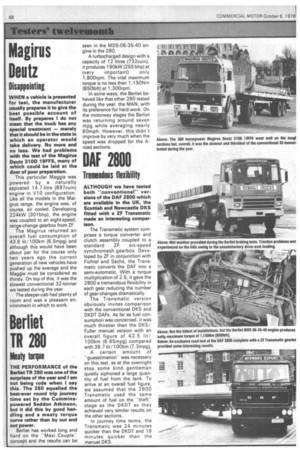DAF 2000
Page 72

If you've noticed an error in this article please click here to report it so we can fix it.
Tremendous flexibility
ALTHOUGH we have tested both "conventional" versions of the DAF 2800 which are available in the UK, the Scottish and Newcastle DKS fitted with a ZF Transmatic made an interesting comparison.
The Transmatic system comprises a torque converter and clutch assembly coupled to a standard ZF six-speed synchromesh gearbox. Developed by ZF in conjunction with Fichtel and Sachs, the Transmatic converts the DAF into a semi-automatic. With a torque multiplication of 2.5, it gave the 2800 a tremendous flexibility in each gear reducing the number of gear-changes dramatically.
The Transmatic version obviously invites comparison with the conventional DKS and DKDT DAFs. As far as fuel consumption was concerned, it was much thirstier than the DKS / Fuller manual version with an overall figure of 42.5 lit/ 100km (6.65mpg) compared with 38.7 lit/100km (7.3mpg).
A certain amount of "guesstimation" was necessary on this test, as at the overnight stop some kind gentleman quietly siphoned a large quantity of fuel from the tank. To arrive at an overall fuel figure, we assumed that the 2800 Transmatic used the same amount of fuel on the "theft" stage as the DKDT as they achieved very similar results on the other sections.
In journey time terms, the Transmatic was 24 minutes quicker than the DKDT and 18 minutes quicker than the manual DKS.


























































































































































